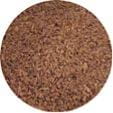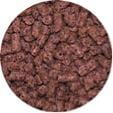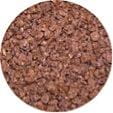General nutrient requirements
Feeding poultry for optimum growth and production requires that the birds consume appropriate, balanced diets. Nutrient recommendations are different for each species and the purpose of the birds (meat versus eggs), as well as the stage of growth and production. Cross feeding, such as feeding laying hens a diet that is intended for broiler chickens, is not advised. Therefore, raising mixed flocks should be done with caution.
Table 1, located at the end of this webpage, illustrates guidelines for some of the major nutrient requirements for poultry. The table does not contain information regarding vitamins and most of the minerals, but vitamins and minerals are important for proper growth and development of the birds.
The crude protein recommendations are estimations for amino acid requirements. Crude protein can vary somewhat and still allow the birds to grow. Birds cannot utilize all forms of phosphorus in feeds; therefore, recommendations in the table are based on available phosphorus. Although total phosphorus concentrations appear on feed bags, appropriate adjustments are made when diets and supplements are formulated.
Nutrients
Crude Protein
Dietary protein is important for animal growth, development and maintenance. Protein is composed of amino acids. Since amino acids differ in concentration with each protein source, the quality of protein varies, influencing its nutritional value.
Amino acids are either essential or non-essential. Non-essential amino acids can be produced by the birds when necessary, but essential amino acids must be provided in the diets because the birds cannot produce them. The balance of dietary amino acids is also important, as birds will not perform well if the ratio of one or more amino acids to the others is not appropriate.
Protein can be found in most feedstuffs, although feeding cereal grains alone does not provide enough of the essential amino acids or a balanced amino acid profile. Therefore, cereal grains must be mixed with other protein-rich ingredients to meet the amino acid requirements of the birds for growth and development. Sources of concentrated protein are soybean meal, canola meal, legumes (peas, lentils), meat meal and fish meal.
Energy
Animals require energy for growth, maintenance, digestion and reproduction. Most dietary ingredients contain energy released by the breakdown (burning) of fats, carbohydrates and protein.
The major energy sources in poultry diets are cereal grains, such as wheat and corn, which have a high starch content. Concentrated sources of energy, including fats and oils, are usually provided to obtain optimum growth and performance.
Vitamins
Vitamins and minerals are required by all animals in order to maintain health and maximize production.
Vitamins are organic compounds required in small amounts. Their function is to assist physiological processes, including normal growth, feathering and leg development. Deficiencies of various vitamins may cause problems such as skin lesions, nervous disorders, muscle problems, reduced egg production in layers, reduced growth in meat birds and improper chick development in eggs from breeding birds.
Minerals
Minerals are often classified as macro or trace minerals in reference to the concentrations required. Macro-minerals such as calcium and phosphorus are generally required in larger quantities than trace minerals like iron, copper and iodine. In some cases, the ratio of one mineral to another is important. Calcium to phosphorus ratios are a primary example. Minerals are important for structural components such as bones and physiological processes. Deficiencies can lead to problems similar to those caused by inadequate amounts of dietary vitamins.
Essential vitamins and minerals are not always found in sufficient quantities and/or available forms in the feedstuffs used for poultry. Therefore, they are supplemented in diets by using vitamin and mineral premixes. Premixes are formulated specifically for each species, as well as the stage of growth and/or production. Vitamins and minerals are found in commercial feeds at adequate amounts. If mixing ingredients with a supplement or concentrate on farm, instructions can be obtained from the feed tag or by consulting with the feed company's nutritionist.
An excess or deficiency in vitamins and minerals fed to poultry may lead to sickness or disease.
Water
Water is not often thought of as a nutrient, but it is an important nutrient because it regulates body temperature, transports other nutrients, and takes part in numerous chemical reactions in the body. Therefore, water should be available to the birds at all times.
Water consumption can be affected by feed type, stage of production and growth, disease status and environmental temperature. The volume of water required for poultry is often estimated by multiplying the daily feed consumption by two.
For example, if a group of birds is eating 10 kg of feed per day, the estimated daily water consumption is 20 litres (10 kg feed x 2 = 20 kg water. One kg water = one litre of water).
Birds can drink up to twice their estimated daily water consumption under hot environmental conditions.
Water quality is an important consideration when planning to raise animals. More information about water quality for livestock is available on the Livestock Water Quality web page and from the Livestock Water Quality guide. This page includes information on water quality test results and a list of feed and water testing labs.
Feed
Feed formation
The different forms of feed include mash, crumbles and pellets, which differ in size and texture. Newly hatched chicks are unable to eat large pellets developed for older birds and are usually fed diets in mash or crumble form.
Mash diets
 Grain is ground and mixed with other ingredients. If the mash is too fine, it will build up on the beaks and can cause tissue damage. Birds raised from start to finish on mash diets tend to grow slower than those raised on pelleted or crumbled diets.
Grain is ground and mixed with other ingredients. If the mash is too fine, it will build up on the beaks and can cause tissue damage. Birds raised from start to finish on mash diets tend to grow slower than those raised on pelleted or crumbled diets.
Pelleted Diets
 These diets are a mash that has gone through machinery that compresses the feed into pellets. Pellets are easily swallowed by the birds as long as they are not too large.
These diets are a mash that has gone through machinery that compresses the feed into pellets. Pellets are easily swallowed by the birds as long as they are not too large.

Crumbled Diets
These diets are pellets that have been broken into smaller pieces. They are generally used for young birds (hatch to three weeks of age).
Complete feeds and supplements
It is not recommended to feed only grain to poultry, because it will not provide a complete or balanced diet. Poultry feed can be purchased from feed mills or their dealers as either a complete commercially formulated feed or as a concentrated supplement to be mixed with grain.
Commercial feeds are formulated as complete diets and contain a balance of all essential nutrients for the particular species. They are fed as the sole ration to the flock and should not be diluted with other ingredients. It is recommended that complete feeds be fed as the starter diets to be sure that the birds get off to a good start. Estimated amounts of starter required per bird for each species are indicated in Table 1.
Feed supplements are also formulated for specific species and contain a protein source, often soybean meal, and vitamins and minerals. Extra calcium may be required, especially for egg-laying birds, and can be purchased in the form of oyster shell or limestone. Supplements may or may not contain medications and/or enzymes; this information will be indicated on the feed tags. The supplements are to be mixed with a carbohydrate source, likely grain, according to the instructions on the feed tag. The instructions should be followed carefully, with any questions directed to the feed distributor, feed mill or the Agriculture Knowledge Centre at 1-866-457-2377.
Making diets using supplements
When mixing a feed supplement with other ingredients, it is important to follow the instructions and mix the ingredients according to weight, not volume.
Over-diluting the supplement with grain will result in birds not consuming adequate amounts of vitamins, minerals and other nutrients.
The following chart shows three examples of how a supplement could be mixed with other ingredients if the inclusion level of the supplement is 20 per cent and the total amount of feed required is 1,000 kg.
Chart 1: Three sample diets of a supplement mixed with other ingredients
| |
Laying Hen - Diet 1
|
Laying Hen - Diet 2
|
Broiler Chicken Diet
|
| |
level
|
weight
|
level
|
weight
|
level
|
weight
|
| Ingredients |
(%)
|
(kg)
|
(%)
|
(kg)
|
(%)
|
(kg)
|
Supplement (layer)
|
20
|
200 |
20 |
200 |
- |
- |
Supplement (grower)
|
- |
- |
- |
- |
20 |
200 |
Wheat
|
50 |
500 |
35 |
350 |
35 |
350 |
Barley
|
25 |
250 |
20 |
200 |
30 |
300 |
| Oats |
- |
- |
20 |
200 |
15 |
150 |
| Calcium source |
5 |
50 |
5 |
50 |
- |
- |
| Total |
100% |
1000 kg |
100% |
1000 kg |
100% |
1000 kg |
The cereal grain most commonly used is wheat, but other suitable ingredients are discussed below. The inclusion level of cereal grains can be changed according to availability, although some limitations are noted below.
Grains that are satisfactory
Cereal grains, including wheat, barley, oats, corn and triticale, are satisfactory for feeding poultry species. Grain screenings are also acceptable, but should form only a portion of the diet.
Rye grain should not be fed to young birds, as they cannot properly digest it. Inclusion levels of rye in laying hen diets can range from 15 to 20 per cent because adult birds are more capable of digesting this grain. Avoid feeding rye if it's contaminated with ergot.
Hulled and hulless barley and oats contain a carbohydrate, β-glucan, which interferes with digestion and nutrient availability in young birds. These grains can be fed more successfully to birds when the enzyme β-glucanase is included in the diet to break down the β-glucan.
If the amount of barley in the diet is increased gradually as birds age, β-glucanase may not be required. Feeding barley without an enzyme is not recommended for young chicks.
Grain screenings are an acceptable ingredient for poultry diets, but due to their variability, they should be mixed with other grains to stabilize the carbohydrate content. The type and concentration of weed seeds in the screenings varies among samples.
It should be noted that weed seeds may negatively influence the taste of the feed.
Weed seeds can also contain anti-nutritional factors and, when fed to laying hens, may affect egg quality.
Use of whole grains
The gizzard is in the upper digestive tract of poultry and is used to grind up large feed particles. Whole grains can be fed successfully to poultry if they are introduced gradually to allow for gizzard development. For example, whole grain can be added at five per cent to the starter diet and gradually increased to a maximum of 50 per cent.
A source of grit may help to digest the whole grain, but does not appear to be necessary. If grit is used, an insoluble form such as granite, sand or gravel should be used for meat-birds. Feeding oyster shell as grit to meat-birds can cause a mineral imbalance that may lead to skeletal problems because it is also a source of calcium.
Whole Canola Seed
Ground canola seed can be used as an energy source that provides additional protein. Diet inclusion levels should not exceed five to 10 per cent. Due to the high oil content of the canola seed, it is easier to grind it in a 50:50 mixture with grain.
Legumes
Legumes such as peas and lentils can be added to diets, along with grain and a poultry supplement. Legumes tend to contain low concentrations of some amino acids (especially methionine), so they are best used in combination with other ingredients. Although there are limitations when using legumes in poultry diets, levels up to 40 per cent are acceptable.
If fed to laying hens, faba beans contain compounds that can cause a reduction in egg size and yolk membrane fragility. Therefore, they should not be added to diets for laying birds. However, faba beans can constitute up to 20 per cent of a diet fed to younger and non-laying birds.
Mycotoxins
Mycotoxins are toxins that are produced by certain fungi and can cause various health problems in poultry. It is important to consider testing grains for mycotoxins prior to use as feed. A list of labs for feed testing is available on the Water Testing and Feed Contacts Laboratories webpage.
Feed Additives
Medications
Medications are sometimes added to poultry diets to prevent disease. Medication included in commercially processed feed will be listed on the accompanying feed tags. As of December 1, 2018, all medically important microbials (MIAs) require a prescription from a veterinarian. Diets medicated with prescription products cannot be sold to a producer without a prescription from a veterinarian.
Caution must be exercised when using any medication, as medications effective for one species may cause mortality in another species. For example, a medication used to treat poultry may kill dogs and horses, and medication effective for broilers may be harmful to turkeys and waterfowl.
Medication withdrawal times prior to slaughter or product ingestion must be respected. Consult the feed supplier or veterinarian for instructions, or check the feed bag for information regarding withdrawal times.
Medications can also be administered to birds through their water source. The same precautions apply.
Coccidiostats are commonly added to chicken and turkey feed to prevent the parasitic infection known as coccidiosis. Care must be taken when feeding a flock of different species of poultry, as there are sometimes compatibility conflicts with the medication used.
Young birds can gradually develop immunity to coccidiosis when anti-coccidial medication is added to their feed and then gradually eliminated. Generally, commercial starter feeds are medicated, but grower and finisher feeds are not. The feed tag will indicate whether or not the feed has been medicated.
Medicated feeds for the prevention of coccidiosis must not be used to treat an outbreak of coccidiosis, as the concentration is not appropriate for treatment.
Growth promotants
Growth promotants are low levels of antibiotics added to feed for their growth-promoting effects. The federal changes to MIAs on Dec 1, 2018, also included the removal of growth promotion claims from prescription drug labels. The use of growth promotional claims in livestock feeds is considered an inappropriate use of antimicrobials and is discouraged. Consult with a veterinarian to discuss appropriate use of antimicrobials in poultry flocks.
Table 1: General Nutrient Requirements1,2,3
| Approximate Ages (weeks) |
Weights at Period End (kg) |
Crude Protein (%) |
Calcium (%) |
Available Phosphorus (%) |
| Laying Chickens |
| Starter (0-6) |
.45-.60 |
18 |
.9 |
.45 |
| Grower (6-17) |
1.18-1.33 |
16 |
.8 |
.45 |
| Pre-lay (17-19) |
1.25-1.38 |
17 |
2.0 |
.45 |
| Laying (>19) |
>1.25 |
17-19 |
3.8-4.0 |
.45 |
| Broiler and Roaster Chickens |
| Starter (0-4) |
.6-.7 |
23 |
1.0 |
.45 |
| Grower (4-6) |
1.8-2.1 |
20 |
1.0 |
.45 |
| Finisher (6-8) |
2.5-3.1 |
18 |
1.0 |
.45 |
| If birds are to be raised longer, crude protein can be reduced to 15-16% after 5-6 weeks. |
| Turkeys |
| Starter (0-3) |
1.2 |
28 |
1.20 |
.60 |
| Grower 1 (3-6) |
3.0-4.0 |
26 |
1.00 |
.50 |
| Grower 2 (6-9) |
5.2-8.2 |
22 |
.85 |
.42 |
| Grower 3 (9-12) |
7.5-12.6 |
19 |
.75 |
.42 |
| Finisher 1 (12-15) |
9.6-16.1 |
16.5 |
.75 |
.42 |
| Commercial Meat Ducks |
| Starter (0-3) |
.8-1.3 |
19-22 |
.65 |
.40 |
| 3-7 |
3.3 |
16-17 |
.60 |
.30 |
| Commercial Meat Geese |
| Starter (0-4) |
2.1 |
20 |
.65 |
.30 |
| > 4 |
> 4.0 |
15 |
.60 |
.30 |
1The values for bird weights and nutrient recommendations are approximations.
2Estimated volume of starter required per bird (kg):
Young egg laying birds - 0.9 to1.0;
Broilers - 1.0;
Turkeys - 1.2;
Ducks - 2.0 (by 3 weeks of age);
Geese - 3.5.
Recommendations for laying hens are based on 80 to 100 g feed consumed per day.
3Approximation for mixed flocks.

 Grain is ground and mixed with other ingredients. If the mash is too fine, it will build up on the beaks and can cause tissue damage. Birds raised from start to finish on mash diets tend to grow slower than those raised on pelleted or crumbled diets.
Grain is ground and mixed with other ingredients. If the mash is too fine, it will build up on the beaks and can cause tissue damage. Birds raised from start to finish on mash diets tend to grow slower than those raised on pelleted or crumbled diets. These diets are a mash that has gone through machinery that compresses the feed into pellets. Pellets are easily swallowed by the birds as long as they are not too large.
These diets are a mash that has gone through machinery that compresses the feed into pellets. Pellets are easily swallowed by the birds as long as they are not too large.